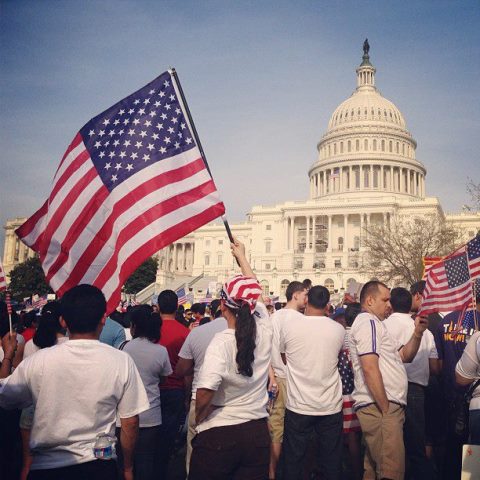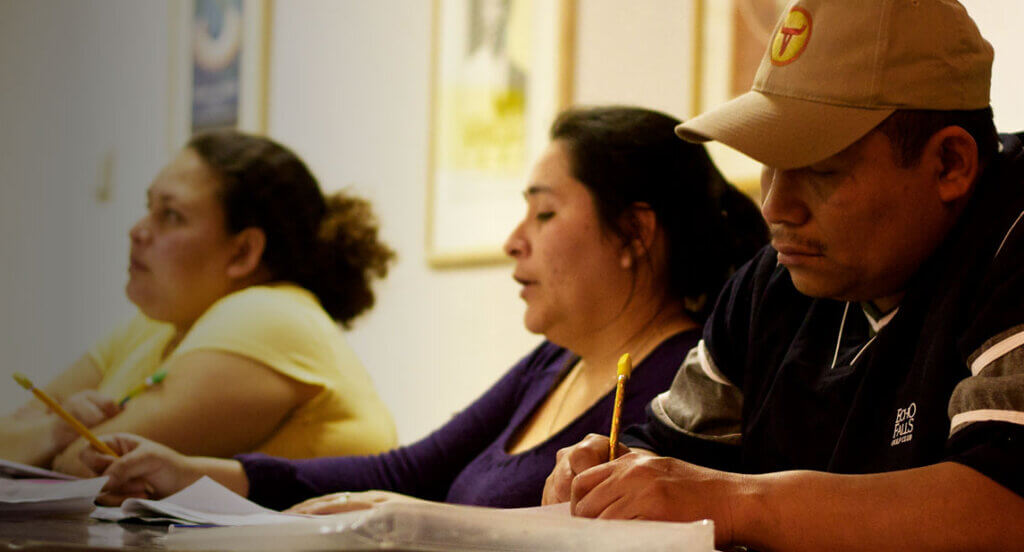What the recent federal budget bill means for immigrants and the Latino community
On March 23rd, President Trump signed into law a $1.3 trillion spending package to fully fund the federal government through September 2018. The bill helps defend and advance many priorities of great importance to the Latino community like making college more affordable, supporting critical infrastructure improvements, and securing vital domestic programs that help working families.

Surprisingly, rather than the drastic cuts proposed by the Trump administration our community was bracing for, the bipartisan spending deal for the remainder of Fiscal Year (FY) 2018 provides an additional $117 billion for these important priorities.
BUT WHAT ABOUT IMMIGRATION?
At first glance, the view from the immigration vantage point may appear dim. Passage of this bill marks yet another Congressional failure, since September 2017, to pass one of the most popular and publicly supported legislative measures—a permanent solution for DREAMers.
To be clear, the disappointment and anger is real. What is also true is that the best opportunity to find a permanent legislative solution was months ago, as we’ve written here.
Since then, federal courts have weighed in on Trump’s callous decision to end the Deferred Action for Childhood Arrival (DACA) policy, and legislative proposals have turned from talks of permanent solutions to temporary patches. Rightly or wrongly, as it pertains to DACA, the latest spending vote felt different than others during the previous six to eight months.
What has remained constant throughout each spending conversation since President Trump took office is his administration’s desire to fund an aggressive—not to mention wildly misguided and cruel—mass deportation agenda.

Since his first executive orders in January 2017 set forth a new policy direction, we have seen a 40% increase in immigration arrests. Subsequent decisions to unwind protections for over a million individuals with protected status have demonstrated a willingness by this administration to follow through with their heartless, destabilizing policies.
As we’ve argued before, never in our county’s history has an administration gone to these lengths to actually grow the undocumented population and to lie about its immigration enforcement operations like this one has.
This vision is reflected in the president’s FY 2018 Budget Request. The administration’s budget requested, among other things, 2.7 billion new dollars for 51,379 detention beds which is 12,000 beds above current levels; millions more to expand the ICE workforce by more than 1,000 new personnel, 850 of whom would have been deportation officers; and nearly $1.6 billion exclusively for the planning, design, and construction of a border wall.
And it’s important to note that the funds desired for the border wall were a separate line item in the president’s budget setting it apart from the billions more proposed for other border enforcement functions like border patrol agents and surveillance technology.
When you push for a hardline immigration agenda, you hurt more than just the immigrant community. #WeAreAllImmigrants https://t.co/71730NVlU8
— UnidosUS (@WeAreUnidosUS) March 26, 2018
WHAT’S IN THIS SPENDING DEAL FOR IMMIGRATION?
To be clear, there are overall increases for the agencies principally charged with enforcing our nation’s immigration laws. But it is also true that while the White House pushed for massive increases in detention beds, deportation agents and border wall funding, Congress gave the President very little of what he wanted.
This is probably why, in a move that perplexed many political observers, President Trump called an impromptu news conference just as government funding was set to lapse to state that he would “never [be] signing another spending bill like this again.” He then proceeded to sign the spending bill anyway.
that he would “never [be] signing another spending bill like this again.” He then proceeded to sign the spending bill anyway.
Here is a snapshot of the spending package that he signed into law:
- No Dollars for a New Concrete Wall. The package authorizes $641 million for only 33 miles of new fencing or levees along the Rio Grande Valley in Texas. It contains explicit language restricting construction to the same see-through fencing design previously used.
- Rest of the Border Money is Largely for Replacing Existing Fencing Plus Technology. The package provides $679 million to replace existing secondary and pedestrian fencing along the Southwest border and in the San Diego border sector. This money is also earmarked for border security technology and other related planning and design activities.
- Minimal New Immigration Agents. The deal denied President Trump the increase in the number of ICE deportation agents he sought (850 deportation officers). It does fund up to 65 new Homeland Security Investigation (HSI) personnel. HSI is the division within ICE that is generally responsible for investigating high profile national security matters, not conducting day-to-day immigration arrests. ICE will also be able to hire 60 new attorneys and other support personnel. Moreover, the package funds the hiring of up to 328 new personnel to staff the U.S. ports of entry, which fall under the purview of Customs and Border Protection. Critically, there is no funding for additional U.S. Border Patrol agents.
- Detention Beds. In many ways, detention capacity and more ICE deportation officers are the necessary conditions this administration needs to fully operationalize and implement its mass deportation vision. So holding the line on these issues is critical. The bill denies the administration the 12,000 beds increase it requested and keeps the levels the same from the previous fiscal year. While the funding levels in this deal decrease the number of detention beds from current levels (ICE currently has 42,000 beds available to detain people per day), it still provides money for about 40,354 jail beds per day. This remains a concern and issue we will track closely in future spending conversations.
- No Provisions Defunding So-Called “Sanctuary Cities.” The administration recently sued California over the state’s “sanctuary city” laws, and threatened other jurisdictions with the withholding of federal funding. In a last-ditch effort to raise the profile of the topic ahead of the spending vote, Trump cobbled together a roundtable to bash jurisdictions that have enacted laws to limit the excessive entanglement between local law enforcement agencies and federal immigration officials. In the end, it was an idle threat.
- More Money to Hire Immigration Judges. The immigration courts received what we believe is welcome funding to hire 100 immigration judge teams, which should enhance due process protections and help reduce case backlogs. Of course, we must remain vigilant in monitoring the attempts by Attorney General Jeff Sessions to strong-arm immigration judges and undermine the rule of law by weakening their judicial autonomy.
The failure to reach a #DACA deal continues a legal limbo for the immigrants covered by the program, who for now are protected from deportation under court orders. #DreamActNow https://t.co/jHWfMo61gO
— UnidosUS (@WeAreUnidosUS) March 26, 2018
Congressional spending fights come up at least once every year as Congress is constitutionally mandated to pass a bill to fund the federal government. On the immigration front, key decisions on the futures of DACA and Temporary Protected Status holders remain unresolved.
Each spending cycle will present its own challenges. But at least for the balance of FY 2018, the Trump administration will have to make do with fewer dollars than it had hoped for to carry out its deportation agenda.
By Carlos Guevara, UnidosUS Senior Policy Advisor
RELATED
For this week’s policy outlook, we dive into what Congress accomplished and didn’t accomplish before going into recess. pic.twitter.com/YYjFCH3duf
— UnidosUS (@WeAreUnidosUS) March 27, 2018


